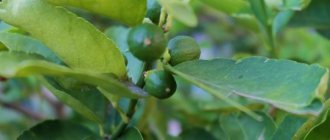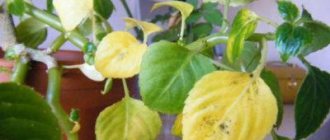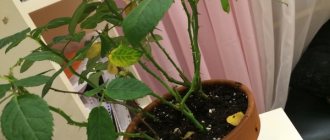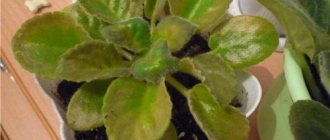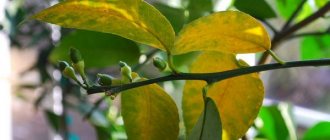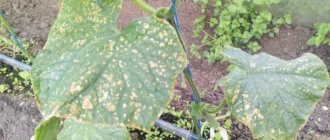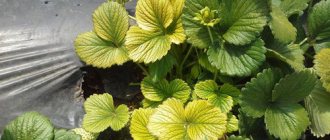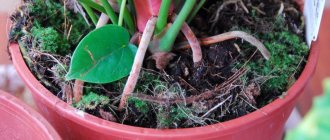Why do lemon leaves turn yellow, fall and curl?
Often gardeners are faced with the fact that lemon leaves turn yellow. There may be several reasons why a lemon turns yellow.
Possible causes may be lack of light or nutrients. All gardeners know that nutrition is very important for citrus crops.
For full development, growth and fruit set, elements such as
- nitrogen,
- phosphorus,
- iron,
- potassium,
- magnesium,
- sulfur,
- calcium.
Nitrogen affects healthy leaf color. Calcium is responsible for the development of the root system. Phosphorus is involved in the construction of plant cells, improves the quality of fruits, and increases their sugar content, vitamins and microelements.
Potassium promotes better nitrogen absorption, accelerates the ripening of woody shoots and fruit ripening, and increases lemon resistance to disease.
Timely application of fertilizers containing the above elements will help prevent yellowing, wilting and falling of leaves. At the same time, the taste of the fruit will improve significantly.
Lighting plays an important role in the formation of a healthy tree.
Citrus, like any other tropical plant, requires 12 hours of daylight. Therefore, lemon is placed on southern, southwestern and southeastern windows. If necessary, use additional lighting.
Another reason why lemon leaves turn yellow is excess light. When direct sunlight hits the plant, or its prolonged exposure to the sun leads to the formation of yellow spots on the leaf blades - miniature burns.
The tree can cope with such burns on its own if it is placed in a shaded or semi-shaded place.
If this is not done, the lemon will completely lose its leaves and die.
Changes in color and spots on lemon leaves
This crop is moisture-loving. Needs regular, abundant watering and high air humidity (70-90%). In extreme heat or when the air in the room is excessively dry, the edges of citrus leaves begin to turn yellow.
To prevent this, you need to spray the tree daily with a spray bottle and also use a humidifier. You can place a container filled with water next to the lemon.
Dry air is often the reason why lemon leaves curl .
In some cases, the leaves turn yellow at the base and then fall off. This can be facilitated by moisture accumulating in the soil and negatively affecting the root system.
With prolonged stagnation of moisture, the roots begin to rot, and the soil acquires an unpleasant odor. In this case, it is necessary to transplant the plant into another container filled with fresh soil.
Pebbles or expanded clay are first laid at the bottom, which will ensure good drainage. Before transplanting, roots that have rotted are removed. Then the root system is treated with a weak solution of potassium permanganate to destroy putrefactive bacteria. After this, the lemon is planted in fresh soil.
Sometimes lemon leaves turn yellow at the edges and curl when there are sudden changes in room temperature. In the same way, citrus reacts to drafts, so a pot of lemon should not be placed near a window or door.
Turning on heating appliances can also cause yellowing of lemon leaves.
Lemon trees love moisture. Moreover, this applies not only to abundant and regular watering, but also to air humidification. If the room is too hot and dry, then the tips of the lemon leaves very soon begin to turn yellow .
This problem can be solved by frequently spraying the plant with a spray bottle, as well as humidifying the air. To achieve the desired result, just place a container filled with water next to the flower. In addition, in such cases, the tray is often filled with pebbles or river sand, which are periodically moistened.
If lemon leaves begin to turn yellow not at the tips, but at the base, and then fall off, then this indicates a poor drainage system . Moisture accumulating in the soil has a very adverse effect on the lemon root system, which begins to rot.
In this case, measures to save the plant should be taken immediately, and they should be drastic.
The lemon must be transplanted into a new flowerpot as soon as possible, which should be filled with at least a third of pebbles or expanded clay. Before transplanting, the roots of the flower should be carefully examined and, using scissors, those parts that have undergone the process of rotting should be removed. Then the root system of the lemon must be treated with a weak solution of potassium permanganate to completely destroy putrefactive bacteria. Only after this can the flower be planted in new soil.
Watering
Have your lemon leaves started to curl into a tube at the ends and then turn yellow? The reason is probably due to insufficient watering of the plant. It is best not to let the lemon soil dry out, as this can lead to drying out and death of the plant. The soil in the pot should always be slightly damp. But if the soil does dry out, it needs to be moistened gradually, with small portions of water at intervals of several hours. Sharp watering of a lemon after a “drought” can negatively affect the plant, and it will shed its leaves.
This is what happens if you don’t water the lemon for a long time and the soil dries out.
Too much watering will also not have the best effect on the condition of the plant. When there is a large accumulation of moisture in the soil, the leaves turn yellow at their base, and not at the tips. Flooding the plant adversely affects the condition of the root system, it begins to rot, and because of this the plant begins to ache and wither.
When overwatered, a lemon leaf begins to turn yellow near the base.
To eliminate the effects of overwatering, the plant should no longer be watered for several days to allow the soil in the pot to dry out. If there is too much moisture, you must replant the lemon in a new pot, after drying the roots a little before planting. It is also important not to forget about drainage.
Signs of regular flooding of lemons - the edges of the leaves darken, gradually turn brown, and the roots may rot.
The lemon needs to be watered as the soil in the pot dries out. The frequency of watering is determined by many factors: the size of the pot and plant, temperature and humidity, and others. In summer, lemons need to be watered more often than in winter: if in winter a couple of times a week is enough for the plant, then in summer the number of waterings needs to be increased and the lemon should be watered every day or a little less often.
Why does a lemon drop its leaves?
At different times of the year, citrus sheds its leaves, but more often this can be observed in the autumn-winter period. The reasons why lemon leaves fall are usually associated with unfavorable conditions in which the tree is kept.
With a lack of light, the plant becomes depleted and begins to lose foliage.
Quite often this happens in winter. In this case, additional illumination with special lamps is required.
Other reasons why a lemon drops its leaves are:
- dry indoor air,
- lack of nutrition,
- insufficient watering,
- cramped pot,
- hypothermia of roots,
- soil acidification,
- sudden change of place
- premature flowering.
To eliminate these problems, you need to provide the plant with regular watering and timely application of fertilizers.
If the pot becomes too small, the tree is transplanted into a larger container. To prevent hypothermia of the root system, you should water the citrus with water at room temperature or a little warmer.
Do not keep it on a cold windowsill. It is important to regularly monitor the condition of the soil and its moisture. With excess moisture, the roots begin to rot, which leads to the shedding of leaves.
When transplanting a tree into a larger pot, the soil may become acidic. To avoid this, the new pot should be 2-4 cm larger in diameter than the previous one. Often the leaves fall off immediately after transplantation, so lemons are initially planted in spacious containers.
Since the lemon quickly gets used to its permanent place, it reacts negatively to the rearrangement and has difficulty getting used to new conditions, as a result of which it can shed its leaves.
Citrus leaves can fall off under the influence of pathogens and various pests, such as scale insects or spider mites. In order to promptly identify and eliminate pests, it is recommended to periodically inspect the tree.
Diseases
The cause of yellowing of the crown and tips of the shoots is often various diseases. Many of them cause similar symptoms. To solve the problem, it is enough to prescribe the correct treatment.
Gommoz
Gommosis is a fungal disease in which cracks form on the trunk and branches . Gum begins to ooze out of holes in the bark. This leads to disruption of sap flow. The crown does not receive enough nutrition, which is why the leaf blades turn yellow and begin to shed their leaves.
To save the plant, the infected shoots are removed and the affected areas on the trunk are cut out. The cut areas are covered with garden pitch, and the indentations on the trunk are washed with copper sulfate and covered with garden pitch. The tree is sprayed with fungicide.
Note! In advanced cases, gommosis cannot be treated.
Root rot
Root rot is one of the most insidious diseases. Its danger lies in the fact that it becomes noticeable only at a late stage of plant damage.
The main visible symptom of root rot is the wilting of the crown - it looks as if it has been scorched.
To save the lemon, it is removed from the pot. The roots are cleared of soil and washed in water at room temperature. All affected areas are cut off. The remaining part of the root system is washed in copper sulfate.
The tree is transplanted into a new pot filled with drainage and soil. All materials must be disinfected. The soil around the trunk is compacted and watered with warm water.
RESCUE OF CITRUS. Lemon sheds its leaves. What to do with citrus leaf fall?
Sooty fungus
Sooty mildew is another fungal disease. A black coating forms on lemon leaves. It can be easily washed with a cloth or damp hand. Without timely treatment, the crown turns yellow and crumbles. The ends of young branches also begin to hurt.
Getting rid of sooty fungus is not difficult. To do this, wipe off the black coating with a damp cloth. Do not put too much pressure on the sheet plate so as not to damage it.
After erasing the sooty fungus, the tree is sprayed with a solution prepared from 1 teaspoon of copper sulfate and 5 liters of water. Another option is to treat the plant with a fungicide.
Note! Sooty fungus only affects citrus fruits with weakened immune systems. In most cases, this disease is a consequence of plant damage by pests.
Scab and warts
Scab and warts are diseases caused by fungi and bacteria. Affected leaves and shoots become deformed. Dark spots and raised formations form on them. The disease affects not only the crown of the tree, but also its fruits.
Without timely treatment, the plant begins to turn yellow and dry out. Eventually the leaves fall off and the lemon dies.
To treat the disease, fungicides are used, for example, Aktara or copper sulfate solution. The product is sprayed on a citrus plant.
Before you start processing the lemon, tear off all affected areas. It is recommended to water the soil in the pot.
Why homemade lemons don't bloom?
Sometimes it happens that citrus does not bloom for a very long time. In this case, the tree can be encouraged to flower by grafting with a cultivated cutting.
After this, flowers will appear in 2-3 years.
The reason why homemade lemons do not bloom may be the lack of a cool winter (at a temperature of 12-15°C), when the plant begins to develop flower buds.
In a warm room, without a dormant period, citrus may not bloom. In addition, the tree may lack trace elements.
Lemons grown from seeds very rarely bloom and bear fruit. To achieve flowering, it is necessary to graft a branch of a fruiting plant. Flowering will occur in 3-4 years.
When planting lemons, you should know that some varieties bloom annually, while others bloom once every 4-5 years.
Why doesn't lemon bear fruit?
It happens that a tree blooms, but does not bear fruit. Why doesn't the lemon bear fruit? There may be several reasons for this. The most common ones are:
- lack of nutrients
- low air humidity,
- lack of light.
With insufficient feeding, the ovary, which has developed to the size of a walnut, crumbles. Sometimes, with scanty feeding, the ovary ripens, but the fruits remain small.
The lack of fruiting may be due to poor pollination. In this case, you need to cross-pollinate the flowers using a cotton swab, transferring pollen from one flower to another.
To get a rich harvest of lemons, you need to create all the necessary conditions for the tree and provide proper care. For example, in the absence of a state of dormancy, the development of the plant is disrupted, which directly affects its fruiting.
Lack of lighting
The natural environment for lemon is the hot tropics, so genetically the plant needs good, long-lasting light. But this does not mean that the tree should be exposed to direct sunlight. Otherwise, the leaves may burn. If there is insufficient light, yellow spots will appear on the lemon leaves. You need to provide the lemon with sufficient light, especially during the cold season. Try to keep it on south-facing windows or use fluorescent lamps for lighting.
Why do the ovaries and fruits of lemons fall off?
It happens that a citrus blossoms, but the ovaries fall off. Why do lemon ovaries fall off? Most often this happens
- due to dry air
- in the presence of drafts,
- excess moisture,
- and also due to lack of nutrients.
Dropping of the ovary can be caused by scale insects and spider mites.
Why do lemon fruits fall off? During fruiting, citrus reacts painfully to even a slight lack of nutrients, as a result of which its yield decreases.
To get a good harvest, potassium fertilizers are applied to the soil in the autumn. You can prepare a solution from water (1 liter) and wood ash (2-3 tablespoons).
It is also worth keeping in mind that a tree sheds its ovary when it feels that it is not ready to bear fruit. It is believed that there should be 10 leaves for each fruit. If there are fewer of them, after flowering the excess ovary is removed.
It is important to correctly form the load of future fruits. Remove excess flowers, leaving 1-2 flowers on the side branches.
If you follow all the rules of care, the question “why lemons fall off” will no longer arise.
Watering mode
For homemade lemon, it is important to follow the rules and watering regime. A middle ground is needed, because both underwatering and overwatering are dangerous for the root system of a houseplant. Excessive moisture leads to waterlogging of the soil. Heavy soil interferes with air circulation, which leads to root rot. The plant stops receiving enough nutrients. First, the tips of the leaves acquire a yellowish tint, then they fall off and the tree dies.
Select the optimal watering regime, which keeps the soil slightly moist. It is better to water several times in small portions. To be on the safe side, you can put a small amount of drainage at the bottom of the pot: after all, if the top layer of soil is dry, this does not mean that there is not enough moisture inside.
Why do lemon branches dry out?
This can occur due to a lack or excess of moisture. Often, dried branches indicate a spider mite invasion.
It happens that branches dry out in winter. In most cases, this indicates that the plant is acclimatizing. In this case, in early spring, the dried shoots are removed, and new ones will appear in their place.
Another reason why lemon dries out is a lack of microelements. It is recommended to alternate fertilizing with nitrogen-phosphorus-potassium or use a balanced fertilizer containing micro and macroelements necessary for the plant.
Citrus responds well to the Root Feeder fertilizer. As a result of its use, the tree pleases with a healthy appearance and a rich harvest.
Lack and excess of fertilizers
Citrus fruits are quite demanding regarding the presence of nutrients and microelements in the soil. If small yellow spots appear on the leaves between the veins, then it’s time to feed the lemon, otherwise the plant will die. Specialized fertilizers for citrus fruits are ideal for feeding. Although you can balance your diet yourself.
But keep in mind that in addition to phosphorus and nitrogen, your pet will also need preparations with magnesium, iron, zinc, potassium, calcium, and sulfur. So if you are not a fanatic gardener, then it is better to buy ready-made fertilizer. An overdose of fertilizers can cause all the leaves to fall off at once. Don’t forget, if you want to calmly enjoy the fruits without risking your health, adhere to measures in the use of fertilizers.
Lemon turns yellow: causes, treatment
Growing citrus fruits at home is not only interesting, but also extremely useful. We all know about the benefits of vitamin C for the body, and citrus plants are rich in this vitamin.
Lemon contains a large amount of vitamin C.
Also, the leaves of oranges, lemons, tangerines and grapefruits contain special volatile phytoncides that kill harmful microorganisms that live in large numbers in any living space and are brought from the street.
Therefore, many flower growers believe that a lemon or tangerine on a window is not only a beautiful exotic, but also a huge benefit for the body.
But there are many subtleties and nuances in growing citrus plants, without which many breeders of these plants simply lose their green pets.
In this article we are trying to understand and find the reason why citrus fruits (lemons, oranges, tangerines, kumquats, limonella, etc.) leaves turn yellow, curl and fall off.
Namely, using the example of indoor Pavlovsk lemon, we will analyze all the reasons for yellowing and falling leaves, and also tell you about treatment methods.
Lemon leaves turn yellow
Possible reasons:
Citrus leaves turn yellow mainly due to lack of nutrition and lack of light.
Treatment:
Nutrition is very important for almost all plants and citrus fruits are no exception. For productive growth, flowering and fruit set, lemon requires the following basic elements:
- nitrogen,
- calcium,
- phosphorus,
- iron,
- potassium,
- sulfur,
- magnesium.
Let's see what role the above microelements play in the life of a plant.
- Nitrogen is required for all life processes, and especially at the beginning of growth and during flowering. Nitrogen also affects the healthy color of leaves.
- Calcium promotes the full development of the root system and green mass of the plant.
- Phosphorus is part of complex proteins and is involved in the construction of plant cells, speeds up fruiting, improves the quality of fruits, increasing their sugar and vitamin content. Normal phosphorus nutrition promotes the respiration of citrus fruits, the good development of their root system, the formation of ovaries and, consequently, productivity. Therefore, the highest efficiency of phosphorus is manifested at the beginning of the growing season, but with the simultaneous introduction of other elements into the soil, primarily nitrogen and potassium.
- Iron plays a significant role in the respiration process and in the formation of chlorophyll in plant cells. In microdoses, plants also require other elements, as well as vitamins (for example, C, B, B12, E, K, provitamin A, or carotene), which accelerate the accumulation and expenditure of energy, the transformation of some substances into others, and promote the growth and reproduction of plants .
- Potassium accelerates the ripening and lignification of shoots, the ripening of fruits, increases productivity, as well as the resistance of trees to diseases. In turn, potassium promotes the absorption of nitrogen. In addition, it increases the intensity of photosynthesis of leaves, improves the metabolism of citrus fruits, and promotes the accumulation of sugar in fruits.
- Magnesium is involved in the construction of tissues, and together with phosphorus - in all metabolic processes occurring in citrus fruits.
Lemon requires 12 hours of daylight, especially in winter.
The location of the plant should be oriented towards southwest or southeast windows. For additional illumination, it is advisable to place special lamps above the plant.
Diseases of indoor lemon
Dry hot air promotes the appearance of spider mites in the lemon crown. This is accompanied by curling, yellowing and drying of the leaves. The plant reacts in a similar way to damage by scale insects and aphids. To combat these pests, you can use special insecticides, acaricides or traditional methods.
Read more: Grapes turn black, why they turn dark and what to do if you get sick
Indoor lemon is a subtropical plant in origin. To prevent yellowing and falling leaves, it is important to provide it with sufficient illumination, high temperature and humidity, abundant watering and a regular supply of mineral elements. Yellow leaves can be a sign of severe stress or pest attack, so if the appearance of the crown changes, you should carefully inspect the plant and adjust the growing conditions.
Indoor plants are quite rarely susceptible to invasion by various types of pests. But anything is possible. Lemons suffer from the same pests as many other plants: aphids, spider mites, scale insects, and whiteflies. They destroy young shoots and leaves, sucking the juice from them. Holes appear on the leaves, they turn yellow, dry out and fall off.
You can treat the plant with special preparations, but you can also get by with a solution with laundry soap or ash. If this does not help, then insecticides should be used, but use them strictly according to the instructions. The ideal option would be to use bioinsecticides that are safe for people and animals.
To help your citrus fruit in time, pay attention to the slightest changes: deformation of leaves, cracks, release of dark brown juice, change in color of branches from green to crimson or brown. At the first signs of disease, you should immediately change the watering regime and remove the affected areas.
These are all the main reasons why lemon leaves turn yellow. But don’t rush to panic, it’s possible that your little lemon is just changing clothes.
Shedding of leaves can also be a consequence of plant infection with fungal diseases or parasites. Among the parasitic reasons why lemon leaves turn yellow are most often aphids and spider mites. Among the diseases is gommosis.
Spider mites most often develop in dry, hot air; characteristic cobwebs appear at the bases of the leaves; the leaves themselves turn yellow, curl, and dry out. The drug Fitoverm is well suited against ticks. If the tree is small, you can dip its green part in hot water, above 60 °C.
A sign of aphid infestation is deformation, yellowing of leaves, and drying out of entire branches. When there are a lot of aphids, its colony is difficult to miss; they concentrate on the back side of the leaf. If there are few insects, then manually remove all affected areas; if there are many, use Tanrek and similar products.
It happens that for no reason at all the lemon drops its leaves. What to do in this case? Check for homosis - gum leakage on the bark. Hommosis often results from other diseases that weaken the plant. It is them that needs to be fought. Moreover, most often, only drugs are used; traditional methods are not very effective here.
If you haven’t found the answer to your questions about growing lemons, ask in the comments.
Lemon leaves may turn yellow at the edges and curl due to sudden changes in room temperature. In the same way, citrus reacts to drafts. Therefore, a pot with a tree should not be placed near a window or door. You also need to protect lemon from possible temperature fluctuations, especially at the beginning or end of the heating season.
Lemon leaves turn yellow with veins
Possible reasons:
Most often, the cause is a lack of nutrition in the soil, as well as a lack of iron in the soil. In second place, homemade lemon leaves turn yellow due to pests.
Treatment:
If the lemon is planted in a small container, we recommend transplanting it into a larger pot and after a week begin feeding it with fertilizers, as well as iron-containing preparations.
If pests are found (spider mites, scale insects, mealybugs, etc.), then it is necessary to take measures to combat them by treating the plant with special insectoacaricides.
Lemon leaves dry out and fall off
Possible reasons:
The most important reason in this case is dry air. Most often, lemon leaves turn yellow and fall off in winter, when the heating is turned on. But citrus fruits are subtropical plants and constant air humidity and long daylight hours are very important for them.
Treatment:
To recreate conditions similar to their native ones, the lemon should be placed away from batteries, closer to a container with water or a water spray.
You can spray the lemon by hand with soft, warm water as often as possible. In a warm, dry room, moisture quickly evaporates and humidity quickly drops, causing the leaves to dry out and fall off.
Diseases and pests that cause leaves to turn yellow and fall off
If your lemon was green, received timely fertilizing and watering, had enough light, but still began to turn yellow, then look for the cause in a disease or pest attack.
Methods of infection and control methods
The plant itself cannot get sick, so you need to establish the source of infection.
Recent Entries
5 working ways to use tar in the garden 7 indoor plants that help you get married even in adulthood Indoor plants that can bloom in trouble
Infection from new “neighbors”
If the lemon is infected from other plants, proceed as follows:
- Inspect all nearby plants and find the source of infection.
- Treat it first, and then your lemon. Look carefully to see if parasites or diseases have spread to other plants.
- Since the lemon does not like it when its geography is changed, move other plantings further away to avoid a second wave of infection.
- Wait 2–3 weeks. Then you can return neighbors if your design requires it.
During treatment, remove other plants and leave the lemon in its original place.
Infection through a window
In rare cases, infection can occur through an open window. The actions in this case are the same: we send the lemon “to quarantine” and spray the plants and soil with preparations.
Infection through soil
Changing or adding soil that has viruses, harmful bacteria or insect pests is also a source of infection. In this case, you can either change the soil again and treat the plant, or use fungicides and insecticides for both the soil and the lemon. During budding and fruiting, you should use preparations that have the “BIO” mark, that is, harmless to humans.
If the lemon becomes infected when changing the soil, you can change the soil again
Identification and treatment of diseases
The correct diagnosis means the correct treatment. To determine the disease, carefully examine the tree or bush.
Anthracnose
This is a fungal disease that causes the foliage to turn yellow and fall off. Characteristic features:
- death of branches;
- bud drop;
- the appearance of reddish spots on the fruits.
To improve health, cut off dead branches, remove spoiled fruits, and spray the plant 2-3 times with an interval of 4 days with Fitosporin or 1% Bordeaux mixture.
With anthracnose, leaf segments turn yellow and dry out.
Chlorosis
Disturbance in the formation of chlorophyll in the leaves can lead to the death of the plant. Characteristic features:
- yellowing begins from the edge of the leaf, while the veins remain green;
- the shapes of the bud and flowers change;
- the size of new leaves decreases.
To improve the health of the plant, water it and spray the leaves according to the instructions:
- Ferovit;
- Antichlorosis;
- iron chelate.
With lemon chlorosis it is difficult to wait for the harvest
If the labels do not indicate the dosage for spraying foliage, then take the dosage for watering and dilute it with water (2 parts water to 1 part solution).
Lemon leaves are falling sharply
Possible reasons:
Most often, the sharp fall of green lemon leaves is associated with stress, namely: draft (open windows and vents in cool weather), overfilling or underfilling of soil, moving the pot to a new place.
Treatment:
Take all measures to ensure optimal conditions for the full growth and development of the lemon: remove the plant from a draft, stop watering for several days when flooded, or replant the lemon in new soil.
Principles of proper care
In order for lemon to feel good at home and its leaves not to turn yellow, you need to follow the rules for caring for this whimsical plant:
- The lighting should be bright but comfortable. It is best to place the lemon pot on the south or east side. If there is insufficient light, artificial lighting should be added.
- Drafts and temperature changes must be avoided. Do not place a lemon near a radiator or next to an open window.
- Do not overwater the plant. If this happens, the lemon needs to be replanted. If the roots rot, they need to be trimmed and dried.
- To ensure that the plant has enough nutrition, fertilizing should be used. It is best to choose special fertilizers for lemon.
- To maintain optimal humidity, the leaves need to be regularly sprayed with water. A humidifier will not be amiss.
- If pests are detected, it is necessary to thoroughly wash the inside of the leaf with a soapy solution or treat the tree with insecticides.
With proper care, lemon looks great. If you neglect to care for the citrus tree, it may die. When yellow leaves appear, it is necessary to immediately identify the cause and eliminate it.
Let's watch an interesting video with care recommendations:
